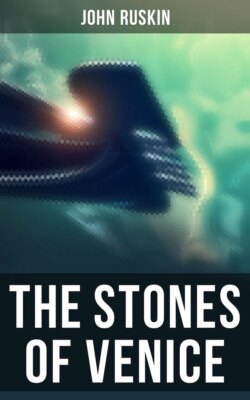The Stones of Venice

Реклама. ООО «ЛитРес», ИНН: 7719571260.
Оглавление
John Ruskin. The Stones of Venice
The Stones of Venice
Table of Contents
Volume 1. THE FOUNDATIONS
PREFACE
CHAPTER I. THE QUARRY
CHAPTER II. THE VIRTUES OF ARCHITECTURE
CHAPTER III. THE SIX DIVISIONS OF ARCHITECTURE
CHAPTER IV. THE WALL BASE
CHAPTER V. THE WALL VEIL
CHAPTER VI. THE WALL CORNICE
CHAPTER VII. THE PIER BASE
CHAPTER VIII. THE SHAFT
CHAPTER IX. THE CAPITAL
CHAPTER X. THE ARCH LINE
CHAPTER XI. THE ARCH MASONRY
CHAPTER XII. THE ARCH LOAD
CHAPTER XIII. THE ROOF
CHAPTER XIV. THE ROOF CORNICE
CHAPTER XV. THE BUTTRESS
CHAPTER XVI. FORM OF APERTURE
CHAPTER XVII. FILLING OF APERTURE
CHAPTER XVIII. PROTECTION OF APERTURE
CHAPTER XIX. SUPERIMPOSITION
CHAPTER XX. THE MATERIAL OF ORNAMENT
CHAPTER XXI. TREATMENT OF ORNAMENT
CHAPTER XXII. THE ANGLE
CHAPTER XXIII. THE EDGE AND FILLET
CHAPTER XXIV. THE ROLL AND RECESS
CHAPTER XXV. THE BASE
CHAPTER XXVI. THE WALL VEIL AND SHAFT
CHAPTER XXVII. THE CORNICE AND CAPITAL
CHAPTER XXVIII. THE ARCHIVOLT AND APERTURE
CHAPTER XXIX. THE ROOF
CHAPTER XXX. THE VESTIBULE
APPENDIX
Volume 2. THE SEA STORIES
FIRST, OR BYZANTINE, PERIOD
CHAPTER I. THE THRONE
CHAPTER II. TORCELLO
CHAPTER III. MURANO
CHAPTER IV. ST. MARK’S
CHAPTER V. BYZANTINE PALACES
SECOND, OR GOTHIC, PERIOD
CHAPTER VI. THE NATURE OF GOTHIC
CHAPTER VII. GOTHIC PALACES
CHAPTER VIII. THE DUCAL PALACE
APPENDIX
Volume 3. THE FALL
THIRD, OR RENAISSANCE, PERIOD
CHAPTER I. EARLY RENAISSANCE
CHAPTER II. ROMAN RENAISSANCE
CHAPTER III. GROTESQUE RENAISSANCE
CHAPTER IV. CONCLUSION
APPENDIX
INDICES
I. PERSONAL INDEX
II. LOCAL INDEX
III. TOPICAL INDEX
IV. VENETIAN INDEX
Отрывок из книги
John Ruskin
Published by
.....
The Rationalist kept the arts and cast aside the religion. This rationalistic art is the art commonly called Renaissance, marked by a return to pagan systems, not to adopt them and hallow them for Christianity, but to rank itself under them as an imitator and pupil. In Painting it is headed by Giulio Romano and Nicolo Poussin; in Architecture by Sansovino and Palladio.
§ XXXVII. Instant degradation followed in every direction—a flood of folly and hypocrisy. Mythologies ill understood at first, then perverted into feeble sensualities, take the place of the representations of Christian subjects, which had become blasphemous under the treatment of men like the Caracci. Gods without power, satyrs without rusticity, nymphs without innocence, men without humanity, gather into idiot groups upon the polluted canvas, and scenic affectations encumber the streets with preposterous marble. Lower and lower declines the level of abused intellect; the base school of landscape23 gradually usurps the place of the historical painting, which had sunk into prurient pedantry—the Alsatian sublimities of Salvator, the confectionery idealities of Claude, the dull manufacture of Gaspar and Canaletto, south of the Alps, and on the north the patient devotion of besotted lives to delineation of bricks and fogs, fat cattle and ditchwater. And thus Christianity and morality, courage, and intellect, and art all crumbling together into one wreck, we are hurried on to the fall of Italy, the revolution in France, and the condition of art in England (saved by her Protestantism from severer penalty) in the time of George II.
.....